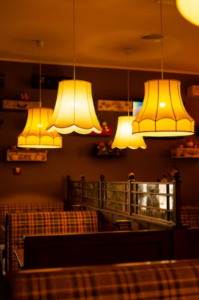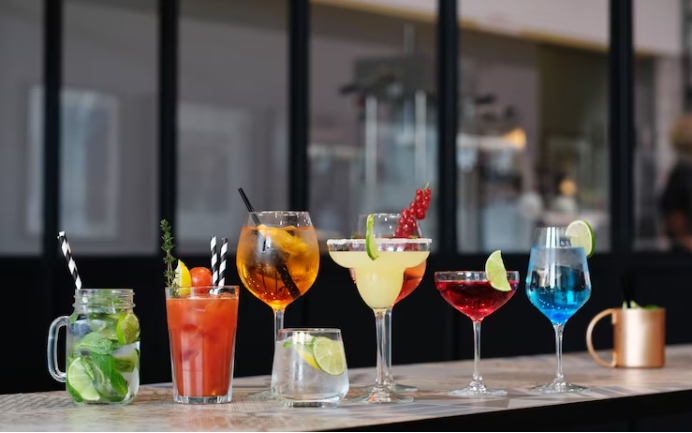Are you aware of the impact that lighting can have on the mood of your restaurant’s customers? The right lighting design can create an atmosphere that enhances the dining experience, while the wrong lighting can leave your customers feeling uncomfortable and unimpressed. Restaurant lighting design is an essential component of creating an environment that sets the right mood for your establishment.
The psychology of lighting plays a crucial role in restaurant design. The right lighting can evoke certain emotions and feelings in customers, making them feel relaxed, comfortable, and even romantic. On the other hand, harsh or dim lighting can be off-putting, making your restaurant feel unwelcoming and uninviting.
With the right lighting design, you can create an ambiance that enhances the dining experience and keeps customers coming back for more.

The Psychology of Lighting in Restaurant Design
The psychology of lighting in restaurant design can make or break the dining experience for customers. The right lighting can evoke a positive emotional response and enhance customer behavior, whereas the wrong kind of lighting can create a negative atmosphere and discourage customers from returning.
Studies have shown that warm and soft lighting can create a cozy and inviting atmosphere, encouraging customers to stay longer and spend more money. On the other hand, harsh and bright lighting can be uncomfortable and uninviting, leading to customers rushing through their meals and leaving quickly.
It’s important for restaurant owners to understand the effect that lighting has on their customers and use it to their advantage in creating a welcoming and enjoyable dining experience.
Different Types of Lighting and Their Effects
Using different types of lighting can greatly impact the ambiance and atmosphere of a space. When it comes to restaurant lighting design, it’s important to consider the different effects of ambient lighting and task lighting.
Ambient lighting provides overall illumination and sets the mood for the space, while task lighting is more focused and directed towards specific areas or tasks, such as illuminating a menu or highlighting a piece of artwork.
In addition to ambient and task lighting, there’s also the choice between natural and artificial lighting. Natural lighting can create a warm and inviting atmosphere, and can even enhance the colors of food and drinks. However, it’s important to consider the potential for glare or uneven lighting.
Artificial lighting can provide more control and consistency, but it’s important to choose the right color temperature and brightness to avoid a sterile or unwelcoming environment.
Ultimately, the choice of lighting should reflect the overall aesthetic and goals of the restaurant, and should be carefully planned to create an inviting and enjoyable dining experience.
Using Color in Restaurant Lighting Design
You can create a captivating dining experience by incorporating color into your lighting scheme, drawing attention to specific areas, and evoking emotions from your guests.
One way to use color is by adjusting the color temperature of your lighting fixtures. Warm colors, such as oranges and reds, create a cozy and intimate environment, while cool colors, like blues and greens, promote a calm and refreshing atmosphere.
You can also experiment with accent lighting techniques, such as spotlighting or colored filters, to highlight specific features of your restaurant, like artwork or architectural elements.
When using color in your restaurant lighting design, it’s important to consider the overall theme and ambiance you want to create. If your restaurant has a modern and sophisticated atmosphere, you may want to use neutral colors, like whites and grays, to create a sleek and clean look. On the other hand, if your restaurant has a more rustic or eclectic vibe, you may want to incorporate bolder colors, like yellows or purples, to create a vibrant and eclectic atmosphere.
By using color effectively in your lighting design, you can create a memorable dining experience for your guests that will keep them coming back for more.
Tips for Choosing the Right Lighting Fixtures
When selecting lighting fixtures, it’s important to consider the overall aesthetic you want to achieve and choose fixtures that complement the style and atmosphere of your space. Lighting placement is another important factor to consider.
Think about the areas of your restaurant that need more or less light. For example, you may want brighter lights in the kitchen and bar areas, but dimmer, more ambient lighting in the dining area. Dimmer switches are a great way to add versatility to your lighting design. They allow you to adjust the brightness of your fixtures to create different moods throughout the day or night.
You can also use dimmer switches to highlight certain areas of your restaurant, such as a display case or artwork on the walls. When choosing fixtures, keep in mind the type of bulb you want to use as well. LED bulbs are energy-efficient and long-lasting, making them a popular choice for restaurant owners.
Consider these tips when selecting lighting fixtures, and you’ll be on your way to creating the perfect ambiance for your customers.
Creating a Cohesive Lighting Plan for Your Restaurant
To pull together the perfect atmosphere in your eatery, it’s essential to create a lighting plan that ties in with the overall theme and vibe.
When it comes to lighting temperature, warm tones are often preferred in restaurants as they create a cozy and inviting ambiance. You can achieve this effect by using warm bulbs or fixtures with a yellow or orange tint. For a more modern and sleek look, cool tones can be used, like blue or white lights. However, it’s crucial to balance the cool tones with warm accents to avoid a sterile and uninviting atmosphere.
Another aspect to consider is spatial distribution. The right lighting can help to highlight specific areas of your restaurant, such as the bar or seating areas. You can achieve this by using different lighting fixtures, such as pendant lights, track lighting, or wall sconces.
Additionally, dimmer switches can be used to adjust the lighting levels according to the time of day or the mood you want to create. With a well-planned lighting design, you can create an ambiance that enhances your customers’ dining experience and makes them want to return again and again.
Do you want to create a unique dining experience that will stand out from the crowd? Click here
Frequently Asked Questions
How much should a restaurant owner expect to spend on lighting design?
When planning lighting design for your restaurant, factors like the size of the space, desired ambiance, and types of fixtures can all affect cost. To find affordable options, consider working with a lighting consultant or exploring online resources.
What are some common mistakes to avoid when choosing restaurant lighting?
When choosing lighting for your restaurant, avoid common mistakes such as using harsh or mismatched lighting color choices. Remember, the impact of lighting on customer experience can make or break your establishment.
How can lighting be used to highlight specific areas of a restaurant, such as a bar or seating area?
To highlight specific areas like the bar or seating area, use different lighting techniques. For the bar, use bright and focused bar lighting to create a lively atmosphere. For a cozy seating area ambiance, use warm and soft lighting to create a relaxed and intimate vibe.
Are there any safety considerations to keep in mind when installing restaurant lighting fixtures?
When installing restaurant lighting fixtures, it’s important to follow safety guidelines to prevent accidents and ensure the safety of your customers and employees. Make sure to also meet the necessary electrical requirements to avoid any potential hazards.
What are some creative ways to incorporate lighting into the overall restaurant design, beyond just functional lighting?
To make your restaurant stand out, think beyond just functional lighting. Use lighting as art to create a unique and memorable atmosphere. Consider custom lighting solutions that enhance your restaurant’s design and brand.
Conclusion
So, now that you have a better understanding of how lighting can affect the mood and atmosphere of your restaurant, it’s time to put that knowledge into practice.
Remember to consider the psychology of lighting, experiment with different types of lighting, and use color strategically.
When it comes to choosing the right lighting fixtures, don’t just go for the cheapest or most convenient option. Take the time to research and invest in high-quality fixtures that will enhance the overall aesthetics and functionality of your restaurant.
And lastly, don’t forget to create a cohesive lighting plan that ties everything together. With these tips in mind, you’ll be able to create a welcoming and inviting space that your customers will love.



